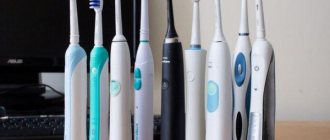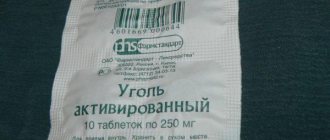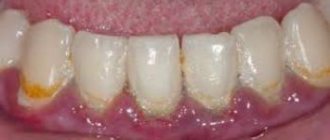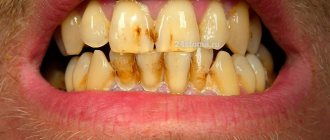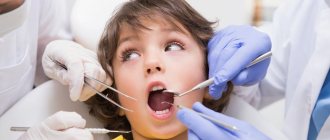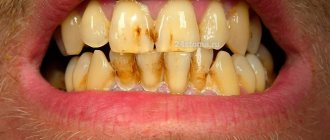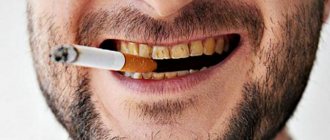Problem: Parents brought their 5-year-old child to Family Dental for professional teeth cleaning. The child has dark plaque on his teeth that cannot be removed with home remedies.
Solution: a brush with an abrasive paste partially removed the pigmented plaque, the remaining plaque was carefully removed with ultrasound, the teeth were polished and the tooth enamel was strengthened. As a result of professional teeth cleaning, the dark plaque on baby teeth is completely removed.
What is Priestley's plaque?
Priestley's plaque is dark stains on children's baby teeth, which are a consequence of the activity of certain types of bacteria.
The appearance of a dark, almost black plaque on a child’s teeth can be observed at any age - both at one year old and at an older age. This is a very common occurrence on baby teeth.
As a result, due to black teeth in children, the smile becomes unattractive, and bad breath often appears.
Priestley's plaque on a child photo
However, it is not the child’s black teeth that should alert parents, but the fact that the appearance of this symptom is a signal that some kind of malfunction has occurred in the baby’s body. And to eliminate it, the first thing you need to do is consult a doctor - a pediatric dentist.
Causes
If a child’s baby tooth or entire dentition has darkened, this may be evidence of:
- carious lesion;
- application of the silvering method in the treatment of caries;
- predominance of carbohydrate foods in the diet;
- calcium deficiency in tooth enamel;
- dysbacteriosis;
- changes in microflora in the oral cavity;
- hidden tooth trauma;
- the use of medications that stain tooth enamel;
- endocrine disorders;
- excess fluoride in water at the stage of formation of hard dental tissues.
In some cases, it is impossible to return the enamel to its original whiteness. But more often than not, a few visits to the dentist and patient training of the child in hygienic dental care are enough for his smile to once again delight his parents with radiant cleanliness.
Causes of black plaque on children's teeth
There are many factors that cause black plaque on baby teeth. It is almost impossible to independently identify the cause, so you need to consult a doctor.
The most common causes of its occurrence are the following:
- Priestley's plaque in a child is the most common cause. This is due to special bacteria that produce a black pigment. It settles on the enamel, but goes away completely with age and almost never transfers to permanent teeth. This phenomenon is not dangerous to health and is considered only an aesthetic problem. Plaque can be removed at the dentist, but after a while it will still return. So you just need to wait until it goes away on its own.
- Caries. An equally common, but much more serious reason, since baby teeth are susceptible to the development of disease. They first turn yellow, black spots and spots appear, after which they turn black. The danger is that the disease will spread to permanent teeth if treatment is not started immediately.
- Dysbacteriosis. This disease can also cause problems with the digestive tract. Often occurs due to poor nutrition of the child, long-term use of antibiotics, and the presence of chronic liver or intestinal diseases.
- Excess iron. Quite often, young children are prescribed iron supplements, which often leads to the appearance of dark deposits on the teeth. At the same time, the color of the plaque can change from black to dark purple or brown.
In addition to the reasons listed, plaque can appear due to a lack of calcium, which certainly affects the teeth first. Sometimes it occurs due to impaired intestinal microflora or as a result of poor heredity - if the child’s parents had the same problem in childhood. In any case, to find out exactly the cause, it is necessary to consult a doctor in a timely manner for examination.
Treatment of caries of primary teeth –
Treatment of caries in children under 3 years of age differs from treatment in older children. The choice of technique will primarily depend on 1) the age of the child and his behavior in the doctor’s chair, 2) the depth of the carious lesion, 3) as well as the behavior of the child’s parents. Typical inadequate demands of parents are “not to paint your teeth black”, “not to give an anesthetic injection”, “not to drill your teeth”, etc. All this makes it difficult to choose the optimal treatment method for a particular child.
1) Treatment of caries in children under 3 years of age –
In children of this age (depending on the depth of the carious process, as well as on behavior in the dentist’s chair), the following treatment methods can be used:
- remineralizing therapy,
- silvering (Fig. 11),
- deep fluoridation (Fig. 12),
- gentle filling of teeth (Fig. 13).
The method of tooth remineralization - remineralization of tooth enamel (saturation of it with calcium and phosphates) is carried out for the initial and superficial forms of caries of primary teeth. The course ranges from 5 to 10 procedures. As therapeutic agents, drugs such as, for example, calcium phosphate gel “GC Tooth Mousse” containing the complex “CPP-ACP” (casein-phospho-peptide-amorphous calcium phosphate) are used. An example of another product is “ROCS-mineral” based on calcium glycerophosphate and xylitol.
All these products can be used not only in the dentist’s office, but also at home. The main requirements are regular oral hygiene and a complete absence of plaque (plus the exclusion of the consumption of easily digestible carbohydrates, including sugary drinks). Treatment will not be effective if these requirements are not met. The drug “GC Tooth Mousse” will be more effective; it is easy to buy online and easy to use at home.
Deep fluoridation method (Fig. 12) - this method is also carried out in the presence of initial caries in the white spot stage, as well as in superficial caries. It is best to apply it in the second stage, i.e. immediately after the remineralization course. In total, a fluoridation course consists of 3-5 procedures, which consist of applying preparations based on sodium fluoride, tin fluoride, amino fluoride (optimally in the form of a varnish, which after application hardens on the enamel surface) to the surface of the tooth enamel.
The effectiveness of the fluoridation process greatly depends on the composition of the product used. It is important to choose an effective and at the same time safe concentration of fluoride for the child. You can read more about optimal medications at the link above. In addition, there is the drug “Enamel-sealing liquid Tiefenfluorid” (Germany), which is two-component and allows you to combine both remineralization and fluoridation at once.
Teeth silvering method (Fig. 11) - this method is used to treat initial caries in the white spot stage, superficial and medium caries. The silvering method is used only for the treatment of baby teeth, because... it causes areas of the tooth affected by caries to turn black. It is usually indicated in children no older than 3 years, because After 3-3.5 years of age, in most cases it is already possible to agree with the child on the traditional option of dental treatment (here, everything basically depends on the ability and desire of the dentist to find an approach to the child).
Of course, it is not entirely optimal to use it for the treatment of foci of demineralization in the form of white spots, as well as superficial caries, because Ideally, in these cases, it is advisable to conduct courses of remineralization and fluoridation. But with average caries (circular and planar forms), this method is not so bad, because In some children, it may be the only opportunity to survive until the physiological change of teeth, i.e. will allow you to do without their premature removal.
The optimal drug is Saforide (based on 38% silver diaminofluoride). According to the recommendations of the Russian Dental Association, silvering of teeth should be carried out not just once, but from 3 to 5 times. Only in this case is it possible to achieve stabilization of the process, but further maintenance repeated courses will be necessary, the period between which can be 1-3-6 months. The duration between repeated courses will depend on a number of factors, for example, the level of oral hygiene, the rate of caries progression, etc.
Gentle filling of teeth in children under 3 years of age - this method is carried out for superficial and medium caries. Don’t worry, filling teeth in children of this age is quite possible, and many dentists treat even 1.5-year-old children in this way. The most important thing here is the approach, and that the child is not scared from the very beginning. For example, it is very important not to cause any unpleasant sensations to the child during 1 visit, and therefore the child first only has his teeth brushed with polishing brushes and a tasty paste, and enamel strengthening agents are also applied to the teeth.
On the second visit, you can begin gentle filling. First, it is necessary to remove the sharp edges of the enamel and softened dentin. This can be done not only with a drill, but also with the help of scraping with hand tools specially designed for this. This is possible because the enamel and dentin in children of this age are much softer than in adults. It is also very important that in young children pain sensitivity in the teeth is reduced, and usually everything is painless.
There is another way to facilitate the removal of enamel and dentin affected by caries. This method involves first applying a special gel (for example, Carisolv, Switzerland), which softens tissues affected by caries and does not affect healthy enamel and dentin. After this, all that remains is to carry out very light scraping with hand tools. Nevertheless, it must be recognized that in some cases, high-quality filling can be carried out only after preparing the carious cavity with a drill, and in this case, only small carious cavities can be cured without anesthesia.
Important points that parents need to know before getting a filling -
- It is very important that the dentist has a “caries marker” drug, which helps the dentist determine whether he has completely removed the dentin affected by caries. In children of this age, this can be very difficult to determine. If the dentist leaves even a little bit of carious dentin, caries will occur under the filling, which will very quickly turn into pulpitis and acute pain. Those. If the doctor doesn’t have such a drug initially, I wouldn’t even sign up for treatment if I were you.
- Selection of material for filling - after removing all tissues affected by caries and appropriate antiseptic treatment, the actual filling begins. The second important point is the choice of filling material. Children of this age can and should have their teeth filled only with “glass ionomer cements” (GIC), for example, “Ketak-molar”, “Ionofil”, “Fuji IX”, “Cemion”, etc. In addition, even with average caries in children, a therapeutic pad made of calcium-containing material is always placed under such a filling.
2) Treatment of caries in children from 3 to 6 years old –
If your child has an initial form of caries (in the form of white chalky spots), then the treatment will be the same as for children under 3 years of age - remineralizing therapy, deep fluoridation, and in the worst case - silvering. We provided a link to these methods just above. For superficial, medium and deep caries in children of this age, it is optimal to use the technique of filling teeth with glass ionomer cements (GIC).
Before filling, carious tissues should preferably be drilled out with a drill, and only as a last resort can scraping of carious tissues with curettage spoons or smoothers be used. Under the glass ionomer filling (if the caries is medium or deep), a spacer made of calcium-containing material must also be placed.
Only if the child is emotionally unbalanced, is very afraid of the sound of the drill, in children who do not allow anesthesia or have a contraindication for it, in children with diseases of the central nervous system, it is preferable to use not a drill, but alternative methods of removing tissue affected by caries. It is also worth considering that if we are talking about a child’s very first visit to the dentist, then no invasive procedures should be performed during this visit (you should limit yourself to only polishing the teeth and applying fluoride varnish). This will allow the child to have a more positive attitude towards the dentist in the future.
Diagnosis and treatment methods of Priestley plaque
The appearance of black plaque can be the result of various diseases. In order to prevent them from starting and to prevent the development of complications, it is necessary to carry out a number of diagnostic measures. Even if a small spot appears on a tooth, you should visit a doctor and undergo laser diagnostics.
If it is caries, then at an early stage of development it is much easier to cure. In addition, the doctor may prescribe additional tests: blood and urine tests. Depending on the results obtained, appropriate treatment methods are selected:
- If problems with the gastrointestinal tract are identified, it is necessary to review the child’s nutritional system. In this case, a special diet is prescribed and some foods are excluded from the diet.
- Lack of calcium or excess iron can be easily treated by taking corrective medications and eating certain foods in greater or lesser quantities.
- When identifying caries at an early stage , dental procedures such as silver plating or fluoridation can help. The doctor treats the teeth with a special solution, which helps prevent further development of the disease and wait for healthy permanent teeth.
- Common Priestley plaque can be removed by professional cleaning by a doctor. But, unfortunately, this is not a guarantee that it will not appear again after a while.
If stains or plaque on the teeth cause pain or discomfort to the child, fillings are used to preserve the teeth and eliminate discomfort.
Irreversible change in enamel color
It also happens that after erupting a tooth immediately stands out in an unusual color - from purple or green to different shades of brown. Parents cannot even imagine why their child’s tooth has darkened. The main reasons for this condition may be the following:
- Taking tetracycline drugs by the mother during pregnancy or treating the baby with tetracycline without the knowledge of the doctor.
- Hemolytic disease of newborns without adequate correction.
- Fluorosis. In this case, the teeth become mottled with dark spots on the glossy white enamel. The disease develops when drinking water with a high concentration of fluoride is consumed during the formation of dental tissues. It's not dangerous, but not aesthetically pleasing.
Teeth with such types of pathology remain multi-colored until the bite changes.
Why do you need to remove Priestley plaque?
Not all children develop dark plaque on their teeth. This is due to the fact that the body reacts differently to changes in diet, environment and other factors.
In some cases, the spots may develop gradually, and in others they form abruptly, in just a few days. At the same time, age is not important: spots can appear already in the first months after teething, although on average they form at 2 years.
There are several reasons for removing Priestley plaque in children:
- Firstly, this is an aesthetic defect that attracts unnecessary attention to the baby’s mouth.
- Secondly, bad breath due to bacterial growth.
- Thirdly, under the guise of spots, the beginnings of carious lesions of the enamel may be hidden.
You can get professional services from a dentist and advice on this issue in Moscow at the Aesculapius dental clinic. Our specialists constantly encounter similar formations in children and know very well how to deal with it.
In just one session we will restore healthy enamel color using completely safe methods. At the same time, services for removing black plaque on a child’s teeth are available inexpensively in our clinic. We cooperate with each client on individual terms and adapt to the patient’s needs.
Also, if necessary, our doctors are ready to perform qualified treatment of childhood caries and other dental procedures. Our medical complex provides a wide range of services and can help with any oral ailment.
White spots on molars
This phenomenon occurs much less frequently than in the case of dairy rows. The process is often observed when installing a bracket system. The problem is provoked by an unbalanced, irregular diet, insufficient consumption of fresh vegetables and fruits, and milk. If this is really the root cause, it is enough to change the diet or reinstall the corrective orthodontic structure.
In adolescence, whitened areas often indicate the onset of caries development. If you contact a dental clinic in a timely manner, you will not need drilling of the affected tissue, filling or cleaning of canals after forced removal of the nerve.
How does the procedure for removing black plaque on teeth work?
Reliably and safely getting rid of dark spots on enamel is possible only with a professional dentist. Self-removal of black plaque in children using various folk remedies can lead to damage to the surface of the teeth.
Therefore, you should not self-medicate, but it is better to immediately use the services of specialists. At the Esculapius clinic we will find the root cause of the violation of the natural microflora of the mouth and eliminate the aesthetic defect from the enamel. At the same time, we use only effective methods that guarantee the highest quality results.
To treat Priestley's plaque, the Air Flow device is used, as well as ultrasound. During the procedure, a mixture of water, air and soda crystals is sprayed onto the teeth under pressure. The flow removes various types of deposits not only from the surface of the tooth, but also from the interdental spaces.
For children who do not really like brushing their teeth using the Air Flow method, soft plaque is removed with special brushes and pastes. After professional cleaning, the teeth are polished and become smooth, due to which less plaque settles on the enamel.
This procedure is available in our clinic at a reasonable cost. In addition, it is inexpensive to perform silvering of baby teeth - a preventive measure to strengthen the enamel and protect against caries, as well as other hygiene procedures. With us, your child's smile will be healthy and beautiful.
Possible complications after plaque formation in children
It is strictly not recommended to ignore the problem and wait until it goes away on its own (unless diagnostics have been carried out and the absence of diseases has been revealed).
Black plaque on a child’s teeth can be not only an aesthetic problem, but also a symptom of more serious and health-threatening diseases, which in their advanced form will require expensive and difficult treatment.
In addition, they can cause complications, which will also lead to unpleasant consequences:
- Inflammation and bleeding of the gums when eating or brushing teeth.
- The risk of developing various dental diseases increases, in particular caries, stomatitis and periodontal disease.
- Dense dark plaque quite often turns into tartar, so even with safe Priestley plaque, professional teeth cleaning is recommended at least once every six months.
- The appearance of bad breath, accompanied by toothache and a feeling of discomfort.
If the progression of plaque is caused by the lack of treatment for caries, the disease begins to fill deeper cavities, which leads to the development of pulpitis, periodontitis and other related diseases. As a result, baby teeth may need to be removed, which is highly undesirable.
Disease prevention
Preventive measures to prevent the development of dental diseases and the formation of plaque should be applied from the moment the baby first starts teething. The risk of unpleasant problems occurring can be significantly reduced by the following simple measures:
- Gentle oral care . Infants up to one year old can clean their gums with a cotton pad soaked in a decoction of chamomile, string, oak bark or sage. Special silicone attachments are also widely popular, which adults put on their fingers and thus clean the baby’s oral cavity. From the age of two, children must be taught to brush their teeth with a brush and toothpaste, and it is also advisable to rinse the mouth after each meal.
- Proper nutrition. This does not imply following any diets, but the child’s nutritional system should be designed in such a way as to limit his intake of sweets, sugar, confectionery and increase the consumption of healthy natural products. Sweets from the store are an excellent substitute for candied fruits, fruits and dried fruits.
- Timely abandonment of pacifiers and bottles. With prolonged use of a bottle or pacifier, an incorrect bite develops, dependence on accessories appears, and a black plaque forms, which in dentistry is called “bottle caries.” You should not delay in weaning your child off devices that he no longer needs.
- Maintaining the immune system. It is important to ensure that even in winter, the child has enough vitamins to maintain healthy teeth and the body as a whole.
By following these simple recommendations, you will ensure your child’s dental health and the beauty of a child’s smile.
Is it possible to fix the problem at home?
Therapeutic tactics depend on the causes of the disease. If the problem is unsuitable water, it is enough to replace it with bottled water or install special filters in the house that remove fluoride from the liquid. The same goes for toothpastes and medications. It is important to avoid fluoride-containing foods.
When a child has grown teeth with white spots, you need to introduce foods rich in calcium and vitamins into his diet. For example, you should eat more vegetables, cheese, and drink milk.
Often the provoking factor is insufficient oral hygiene. Parents must teach their son or daughter how to properly perform hygiene procedures. Any available and effective teaching methods will do. Currently, there are many educational cartoons and programs that will help you learn all the intricacies of regular cleaning in a playful way.

